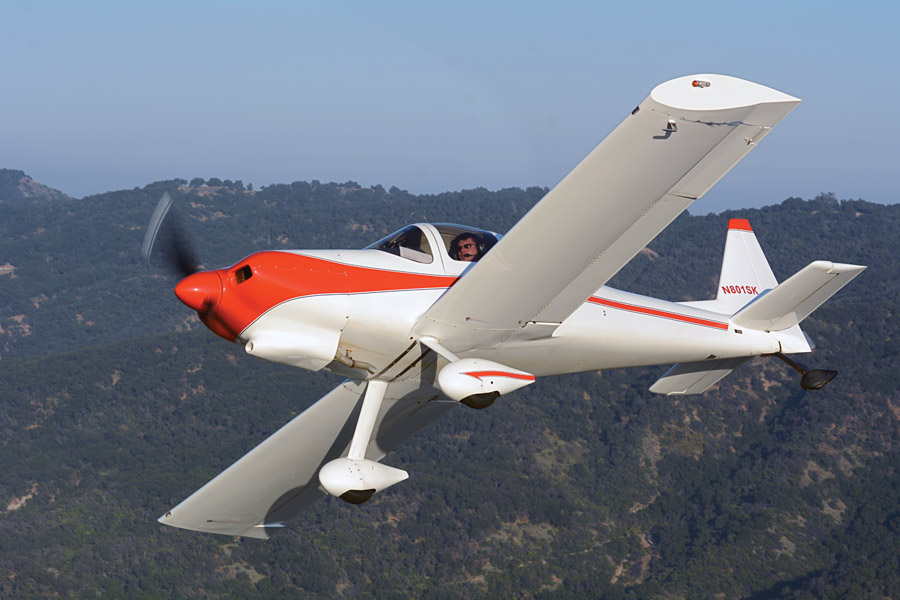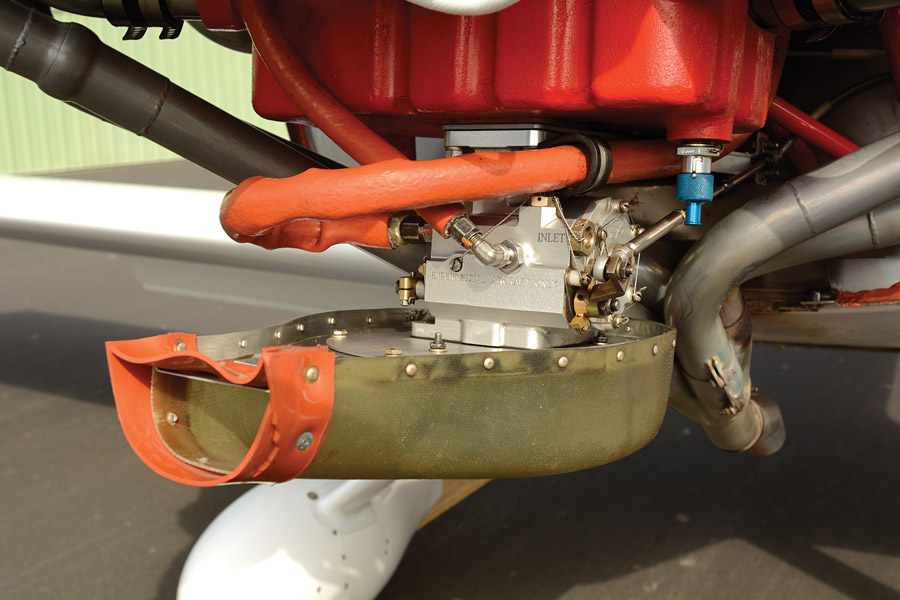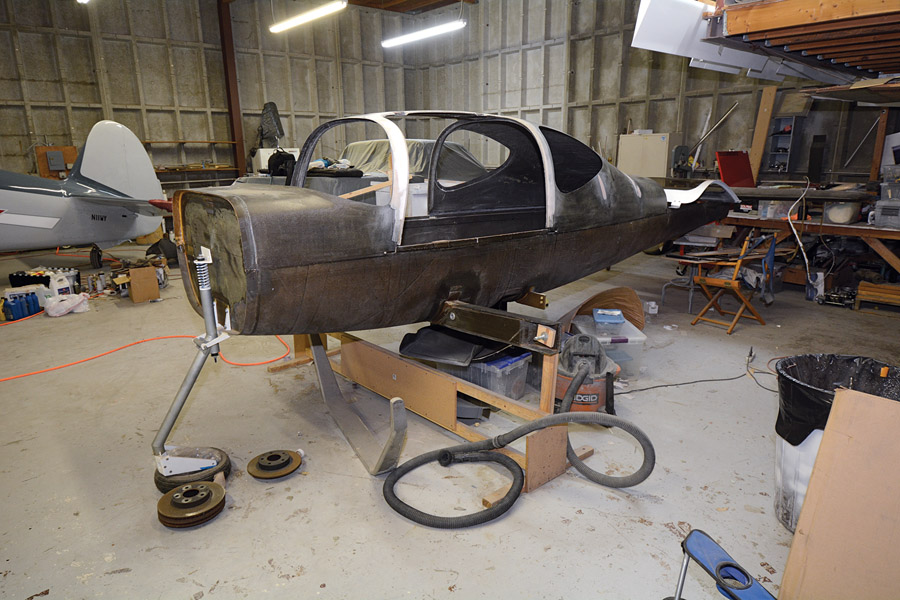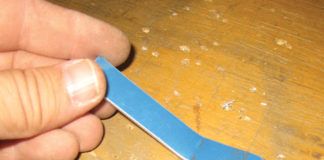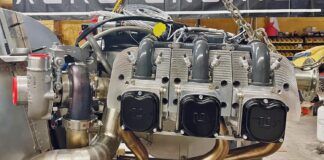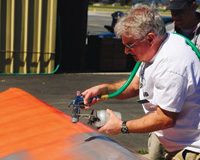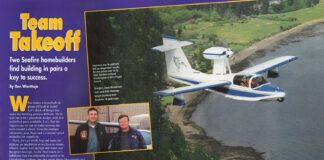Scott Stearns never suffered the question of what airplane to build. Growing up watching his dad restore a T-6 in the family hangar at Camarillo, California, Scott probably didn’t have a chance to wander away from airplanes at any rate, and when the KIS factory demonstration aircraft ended up hangared next door in the 1990s, his association with the composite kit aircraft had already begun.
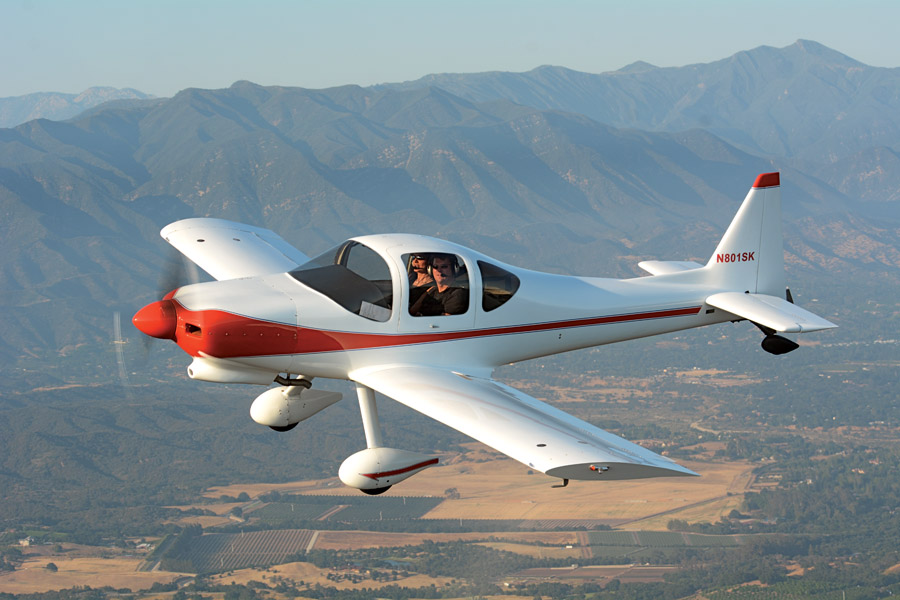
Thanks in part to its precise tube-and-ball-bearing controls, Scott says at first, “the ride in turbulence was terrible.” A positive-G bump would deflect the elevator control tube, commanding up elevator and exacerbating the bump. Fitting a bob weight to the control tube reversed the elevator response for “a massive ride quality improvement.”
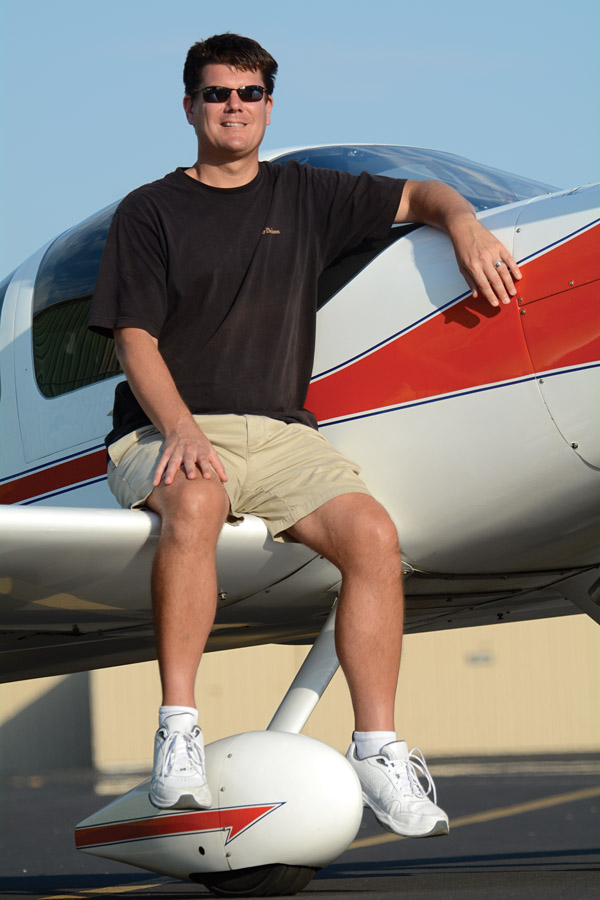
Now flying for United, Scott Stearns is a relatively young and busy man to have completed a homebuilt project. His engineering background no doubt enabled him with the many modifications he’s made to his TR-1.
The KIS Story
One of the outliers of “modern” Experimentals, the KIS two- and four-seaters had a rough start and only a brief time in the market. It began in the 1980s just west of Camarillo, in Oxnard, California. That’s where Richard Trickel had, with partners, set up High Tech Composites and his own Tri-R Technologies marketing company. Tri-R Technologies’ main business was building composite parts for Lance Neibauer’s glamorous new Lancair speedster. Independently Trickel was commissioned to design a composite light plane for an Australian customer, but when he ultimately wasn’t paid, Trickel opted to put the design into kit production as the KIS TR-1 in the early 1990s. Parts were produced in Trickel’s Oxnard shop, with approximately 140 two-seat and perhaps 50 four-seat kits sold, many to Europe and South Africa. Eventually Trickel moved to El Salvador, taking the KIS molds with him, but the rights to the KIS designs were sold, and there was talk of parts production in China. Ultimately nothing came of it, and KIS faded from the scene. Richard Trickel passed away a few years ago; his brother Mark keeps track of completed airplanes as best he can, but there is at best skeletal support for the design. It’s thought 60 two-seat and perhaps as many as 30 four-seat TR-1s are flying worldwide.
Stearns’ TR-1/TD
Scott Stearns was in high school when the KIS demonstrators lived next door, and an association with the KIS team was all but unavoidable. Eventually Scott attended AirVenture with the factory airplane entourage, and by the time he was in college, a friend of his spent a summer interning with Tri-R Technologies. Not much later, in 1998, a fuselage and tail kit became available at a quarter of list price, so Scott scooped them up, storing them in—where else?—his dad’s hangar.
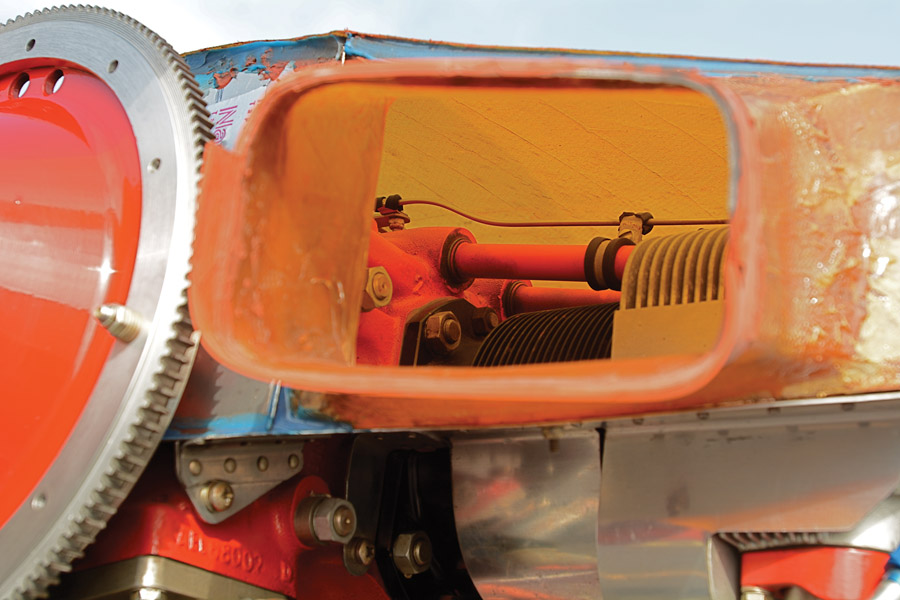
Scott used a Van’s Aircraft baffle kit to start his otherwise homegrown plenum cooling system, but with the KIS cowling sized for an IO-240 Continental, overheating was an issue. Enlarged air inlets—about 20 percent—and plenty of cutting and fitting to the plenum delivered good cooling. Scott would like to redo the plenum just for cosmetics now that it’s been nipped and tucked several times.
Scott’s first job out of college was as an engineer for Burt Rutan at Scaled Composites, over the hill from Camarillo in Mojave. This allowed working at Scaled during the week and fiddling with the TR-1 on weekends, an arrangement that paid off handsomely when Scaled surplused a giant load of pre-preg carbon fiber that was nearing its expiration date. Scott bought it “for pennies on the dollar” in 2000 and used it to bring the already out-of-production KIS wing molds back to life. He had access to those molds thanks to his friend working at Tri-R Technologies, and that friend also took advantage of the pre-preg haul to lay up a complete KIS four-seater.
So, while TR-1 factory kits were all fiberglass, Scott’s employs a fiberglass fuselage, horizontal tail, and rudder, while the wing, flaps, ailerons, and elevator are carbon fiber. The horizontal tail surfaces deviate the most from KIS practice; normally the horizontal tail and elevator are laid up as one piece, then the elevators cut out. But Scott wanted elevators slightly deeper in chord so they were built separately from carbon fiber.
Scott’s time at Scaled was relatively brief as he decided he’d rather fly airplanes than design them, so in June 2000 he headed for the airlines. After the obligatory months instructing and time building, Scott quickly landed in the right seat at SkyWest Airlines, a transition crimping his ability to work on the KIS.
Still, “The kit eventually got to the point where it needed an engine and avionics,” he recalls, along with the decision of what he should really do with it. “Do I cut it up and forget about it or make the commitment to finish the airplane?” Opting to finish, Scott said he spent every spare minute in the hangar building as long as he had the money to buy the necessary parts.
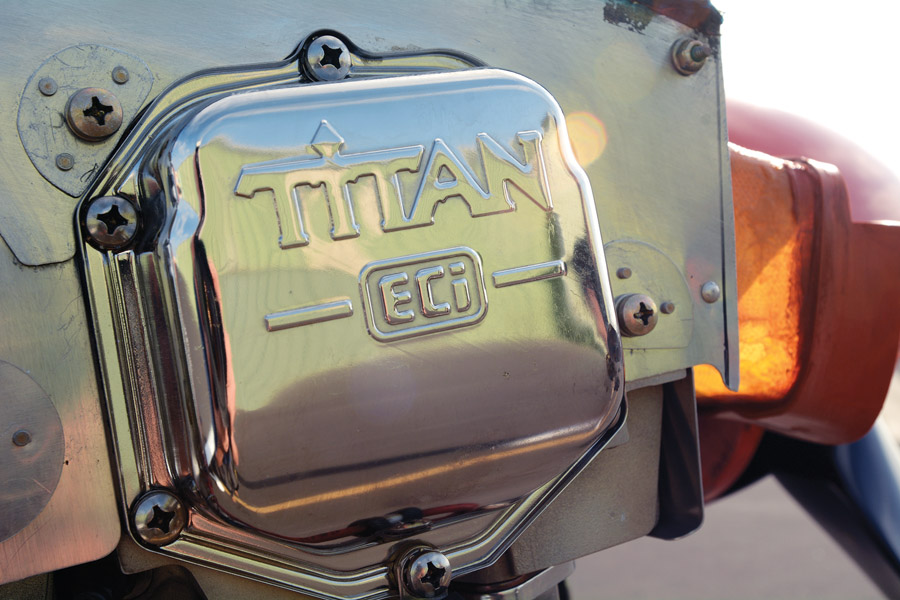
Using an ECI engine kit, Ly-Con assembled Scott’s IO-360-EXP Lycoming clone using their own 10:1 pistons. Scott had Ly-Con dyno the engine for a safe and controlled break-in; it posted 220 hp.
Engine Selection
One of the biggest parts Scott needed was the engine. “I went around and around on engines,” he said. “I looked for used engines and tried to be logical about it, but at a certain point I said to myself, ‘This whole thing is ridiculous, so I’ll buy my fantasy engine for it, which was the 360 [Lycoming] with ported heads, high compression, and fuel injection.'”
Originally designed with such lackluster economy mills as the 80-hp Limbach 2000 or the venerable 100-hp O-200 Continental and 118-hp O-235 Lycoming in mind, Scott was clearly muscling up under the cowling, but with good reason. “I was never worried about sea level performance,” he explained. Instead he, “never wanted to worry about takeoff performance. [I wanted] no high-density-altitude problems.” Therefore, he asked engine builder Ly-Con for the big displacement and high compression, with a goal of accessing 75 percent of the stock 360 Lycoming’s 180 hp at 12,000 feet.
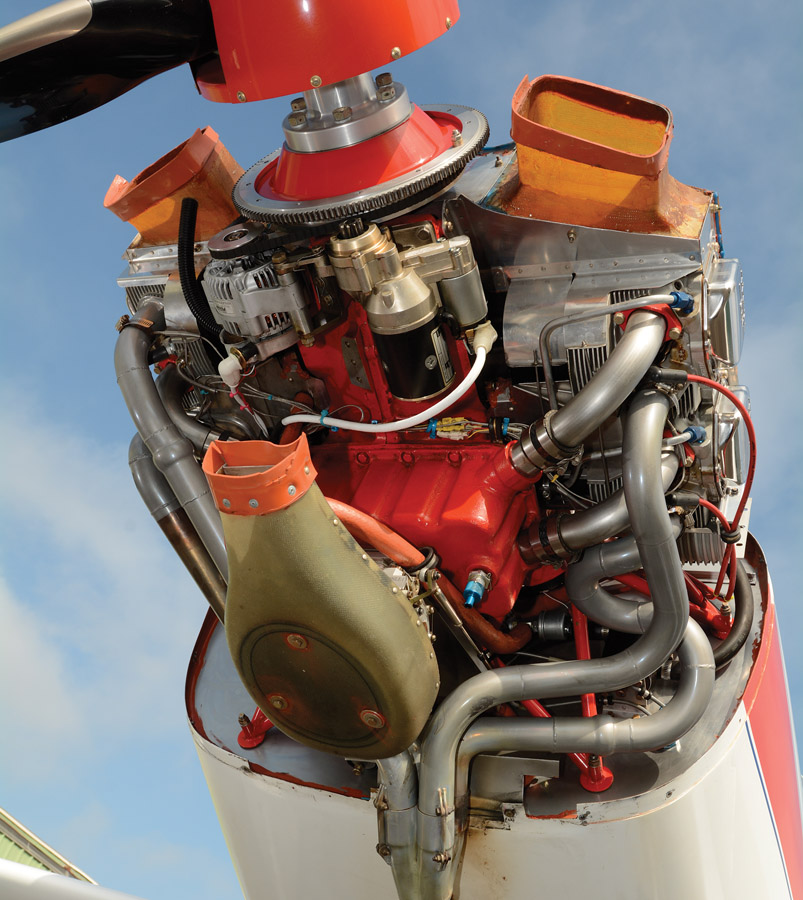
As expected, Scott’s 360 wears lightweight starter and alternator accessories, along with equal-length exhaust headers. It’s a straightforward installation with a minimum of hot rod trickery.
With the basic airframe together and engine hung, challenges arose from the elementary nature of the KIS build manual—it’s pretty much blank from the firewall forward other than to note, “We recommend you use aircraft quality parts.” By his own admission, Scott “kind of re-engineered most of the kit.”

Scott worked with Plane Xhaust Corporation in Ft. Lauderdale, Florida, on his 4-into-1 headers. Like others, Plane Xhaust has the customer use PVC pipe and joints to mock-up the system, which Plane Xhaust then builds in 321 stainless steel.
Flight Controls
The flight controls are a good example of Scott’s changes. “My airplane has the stick between the seats, not between your legs,” so the control system is pretty much scratch built. Many detail parts, brackets and such, were also redesigned by Scott. “The original [KIS] control system was early Lancair 360 parts. While making the kit airplanes, they [Tri-R Technologies] were making the Lancair parts in the Oxnard factory. All the first 300 or 400 Lancair kits—320, 360, ES—were made in the Oxnard factory, so a lot of metal parts [in the KIS] were Lancair parts.” Those parts tended toward plain bushings, “not ball bearings like I wanted.”
“My whole control system is all ball-bearing rod ends, and all joints are ball bearings, even the rudder bearings.” Scott even designed and fabbed his own rudder pedals.
Not surprisingly, Scott reports, “A lot of it was just deciding to figure out the nice way to do something with the control system.” He also did all the airframe and panel wiring himself, but farmed out the intercom harness, as he didn’t think his skills were up to double- and triple-shielded wires.
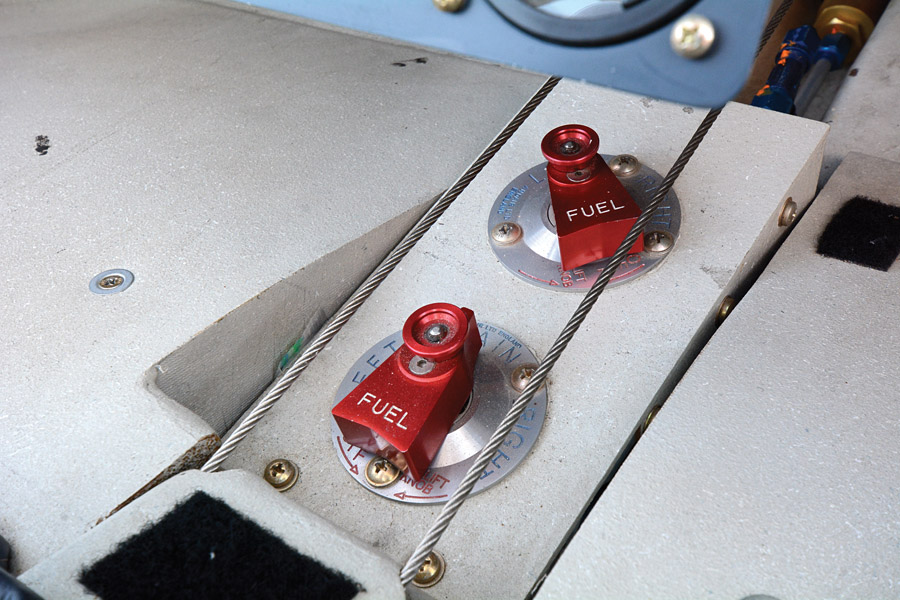
Dual Andair fuel selector valves are another legacy item. Today Andair offers 4-way valves, but when Scott was building, only 2- and 3-tank valves were available. So, the forward valve selects either the left or right forward tank, and the 3-position valve behind it takes fuel from the front fuel selector valve (FSV) and sends it to the engine. Set to “left” or “right,” the rear valve bypasses the forward FSV and draws directly from aft of the spar. Pumping is handled by the usual pair of engine-driven and firewall-mounted electric pumps.
New Doors
Scott also completely reworked the KIS gull-wing doors and redesigned their latches. “The doors were pretty difficult. The door frames were molded from the factory, but didn’t fit the fuselage at all; they were three-quarters of an inch off in places.” From the factory the KIS doors are a glassed-together assembly of an outer skin and molded inner frame. “So I cut the frame in places in the door, [added foam], and re-glassed it back together,” said Scott. He also noted, “The big thing was deciding to get the Dremel tool out and cutting the door into Swiss cheese.” Once committed, the door-fit fix was actually not that much work.
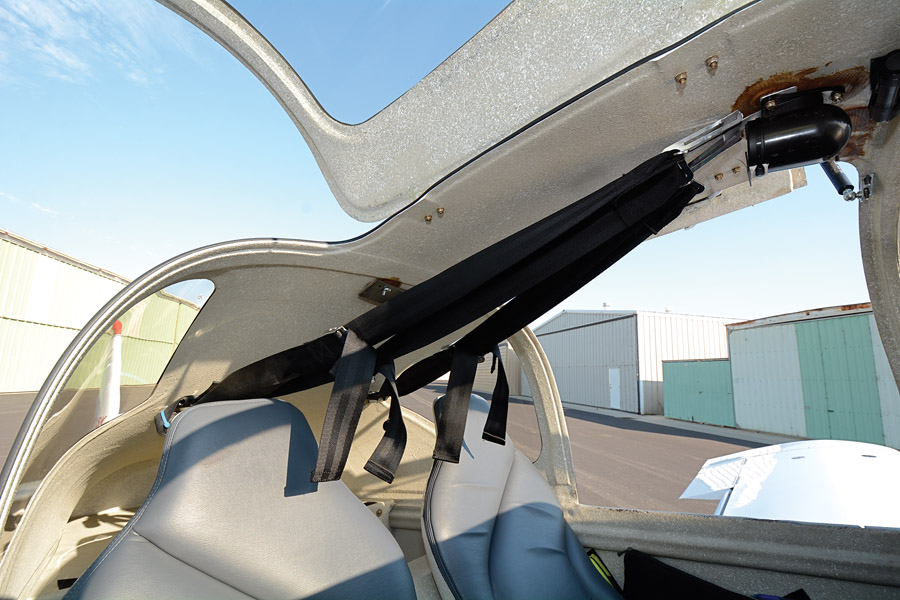
Gullwing doors give fair access to the TR-1 cockpit. Simple hooks in the overhead allow Scott to keep the shoulder belts from fouling ingress and egress; gas struts hold the doors open.
But that can’t be said of Scott’s redesign of the door latches. A KIS weak point, “These came open in flight on many of the airplanes. You would close the door, and the forward pin would go into the fuselage, but the aft would be outside.” In flight, “The door would just leave…it would tear off the airplane, but the plane remained controllable.”
Scott’s solution was a long, single-piece door handle that engages the door sill. There it fits around a stainless steel pin. “It took me a long time to come up with my very simple solution to the problem,” says Scott, but it works. For more door latch detail see Bob Reed’s KIS website.
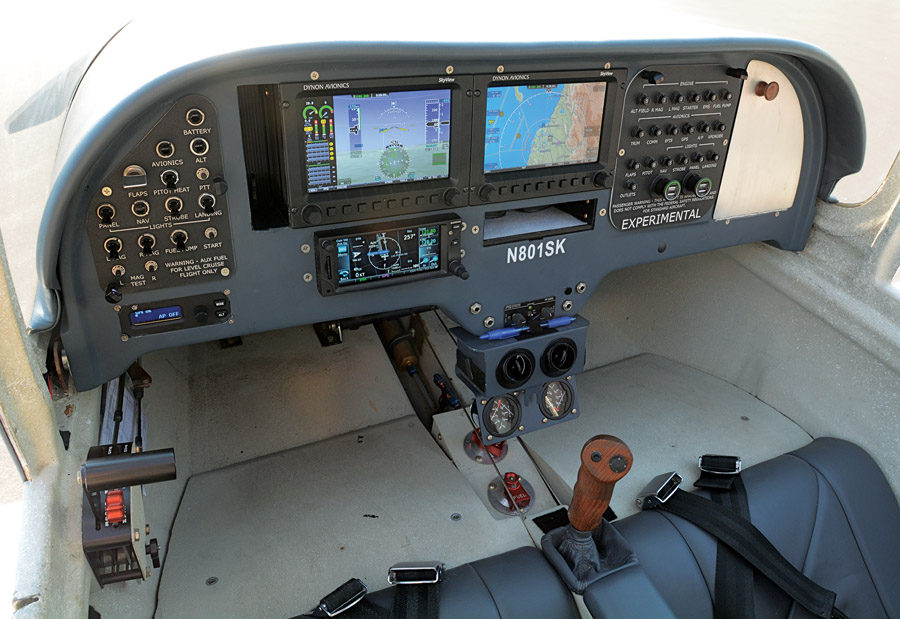
Main attraction on the TR-1 panel is a pair of Dynon SkyView classic (non-touchscreen) D700 displays. Also included is Dynon’s ADS-B Out transponder plus an ADS-B In box to display weather on both screens, primary and secondary Dynon AHRS, Dynon engine sensors, and dual battery backups. Below the Dynons is a Garmin GTN 650, along with a TruTrak Digiflight II autopilot interfacing “really well” with the Dynons. It’s been updated to include altitude and vertical speed. There are no steam-gauge backups; Scott considers the autopilot his main backup.
Custom Fuel Tanks
Another big change was wetting the wing on both sides of the front spar from root to tip. Thus, there are two tanks in each wing, one in front of the spar at about 22 gallons capacity and one aft of the spar holding approximately 30 gallons. This required running the aileron bellcrank all the way out to the wingtip instead of even with the aileron’s inner edge, but yielded no less than 100 gallons total fuel on board, should Scott ever decide to fly to Oshkosh non-stop. “It’ll do that pretty comfortably, but I never have done it,” he reports. “I got married instead,” he jokes, but is quick to say his wife Mahzad is a keen copilot, air camper, and AirVenture attendee, so they’re typically flying two-up in the KIS and have no chance of operating at full fuel weight. “If you had a lightweight pilot, 120 pounds, you could take full fuel,” notes Scott. Most typically they tanker 40 gallons.
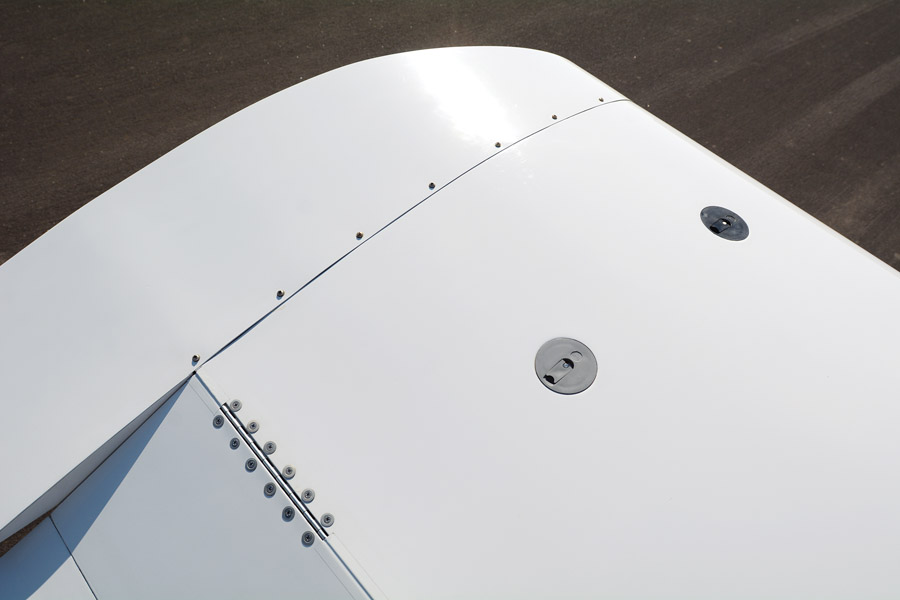
Dual fuel caps way out by the wingtip are a dead giveaway Scott’s TR-1 has continent-crossing fuel capacity. He admits to never yet filling the wings to their 100-gallon limit, but he always has the option to juggle payload for fuel in a meaningful way.
Asked if he emphasized weight reduction during the build, Scott said, “I wasn’t obsessing over weight savings because the carbon fiber [wings, tail] really helped. Each half of the fiberglass cowling was 9 pounds lighter and the wing skins were 4 pounds lighter, so that was another 16 pounds [saved] and the reduced counterbalance weight in the control surfaces saves more weight.” Scott does appreciate his EarthX lithium battery, however. It’s a mere 4.5 pounds, “trouble free, and works well.” Scott notes as a battery it’s expensive, but it’s “really good dollar-per-pound” when weight reducing.
As a young man working full time, it was obviously impossible for Scott to continue to dedicate every spare moment to working on his TR-1, but even with several of the inevitable building layoffs, the plane first flew in 2010. Since then, he and Mahzad have put the little speedster to good use on camping and exploration trips.
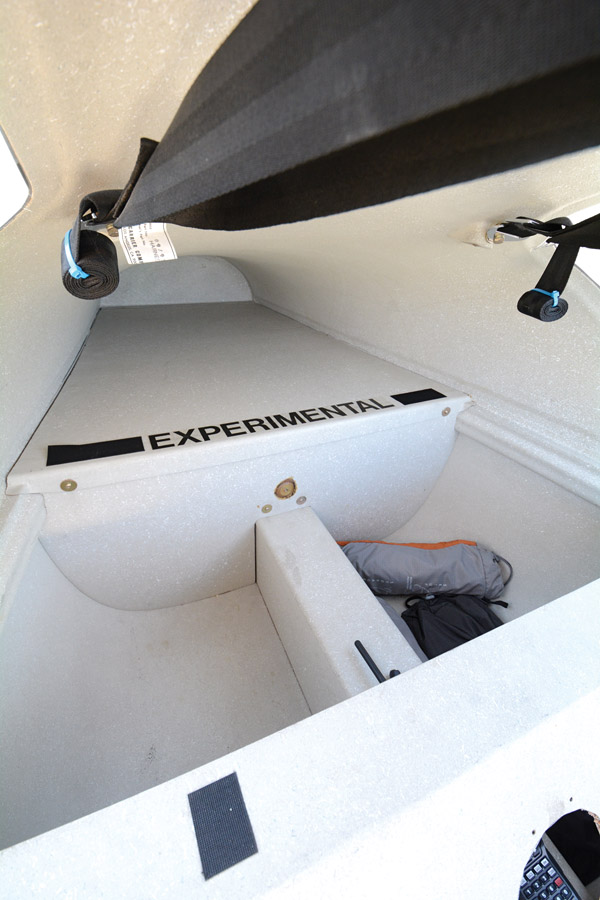
Scott opted to enlarge his baggage compartment to the rear fuselage bulkhead to store long or bulky lightweight items. Pillows, fishing poles, and the like are common aft baggage items on his typical camping or AirVenture trips. He also finds the large compartment yields a more spacious cabin feel.
Post Build
Because few pilots are familiar with the TR-1, and Scott’s example sports significant improvements, there’s a natural curiosity as to how it flies. Scott’s short answer is, “It’s not a beginner’s airplane. It has a lot of power for what it weighs, and [it] runs out of rudder on takeoff and goes left. So I feed in the power slowly…it takes a lot of right rudder.”
“It’s very neutral in pitch; it goes where you point it…there’s also not a lot of speed stability,” he points out. “Like a jet, it goes where you point it. It’s something you really have to be aware of all the time. It’s not going to save you from anything.”
That said, “It flies nice.” Roll and pitch harmony is “pretty good, and if you want a 1, 2, 4 on control forces [ailerons = 1 effort, elevators = 2 effort, and the rudder = 4 effort] mine is 1,1,1. You wiggle the stick just a little bit and the wing wiggles just a little bit. It’s precise because of the ball bearings. You have to kind of get used to it.”
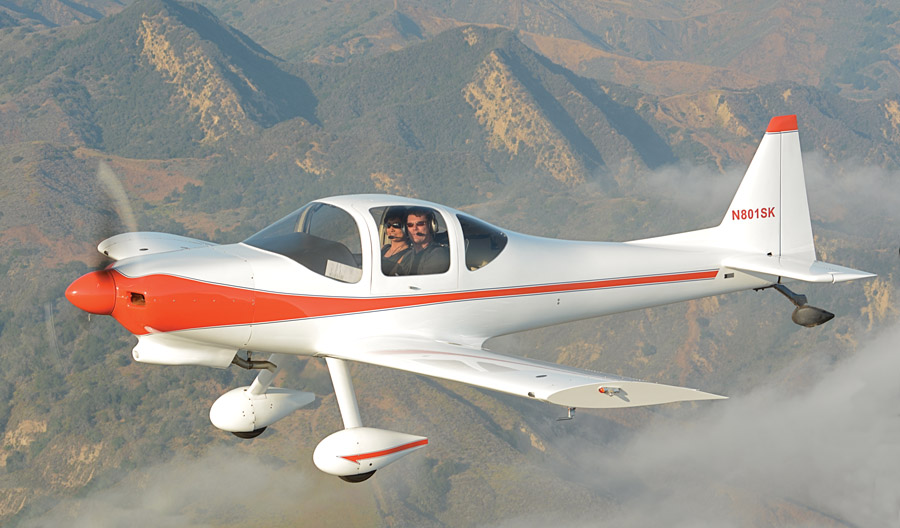
Scott and Mahzad Stearns find the TR-1 a fast and efficient cross-country tourer. Even with “just” 40 gallons of fuel on board, it can cover 620 miles with a one-hour reserve.
If that doesn’t sound like VanGrunsven benign, the performance is a hair above the Oregon standard as well. “I wanted to make 75 percent of rated power—135 hp—at 12,000 feet rather than the stock engine at around 7000 feet, and have the added efficiency of the high-compression pistons. The extra power is fun at low altitude, but I don’t generally run the engine over the 180-hp rating. I normally take off and make my initial climb at 27 inches rather than full throttle. In my opinion, this is how all airplane engines should be built, but unfortunately we live in a world where pilots prefer to listen to gurus rather than the pilot’s operating handbook.”
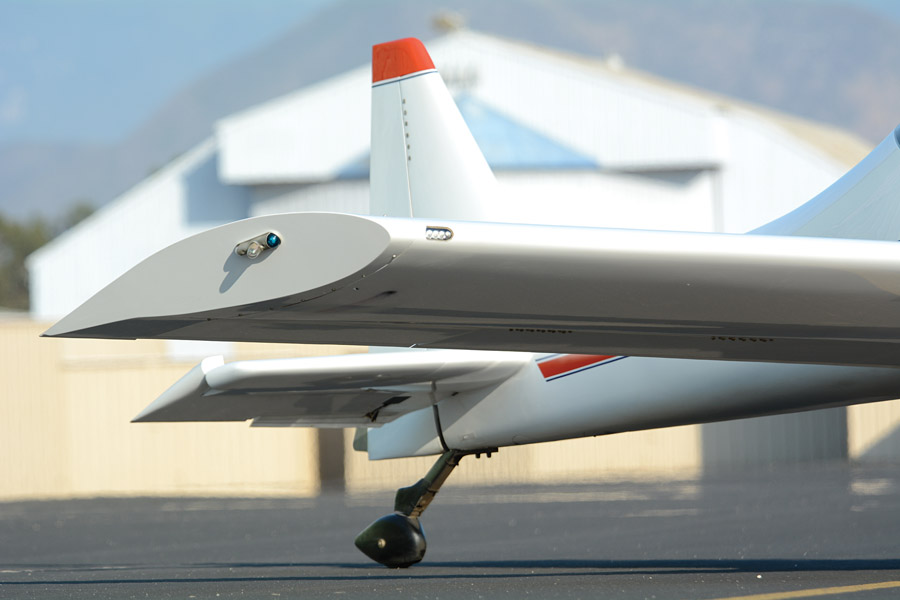
Scott opted to design and build his own fiberglass wingtips. Their key characteristic is the tip angle, said to be optimum for the aspect ratio. Scott says they’re really just a flat plate and easy to build; they’re the only tip he’s had on the TR-1.
All turned up, Scott reports a top speed of 192 KTAS, which could be faster should he bias his ground-adjustable prop in that direction. But he’s got it pitched for 180 KTAS, which he sees at 10,000 feet, 2700 rpm, 20 inches of manifold pressure, and 9 gph. A lower altitude economy cruise is more like 165 KTAS at 5000 feet, 2450 rpm, 20 inches, and 7.5 gph.
Stalls come at 60 KIAS clean and 55 KIAS with the simple piano-hinge flaps down. Rate of climb at 110 KIAS is 1200 fpm and would “go way up” with a constant-speed prop, but with the ground-adjustable set for the 180-knot cruise, the climb is a bit flat to get the engine rpm up in the power band.
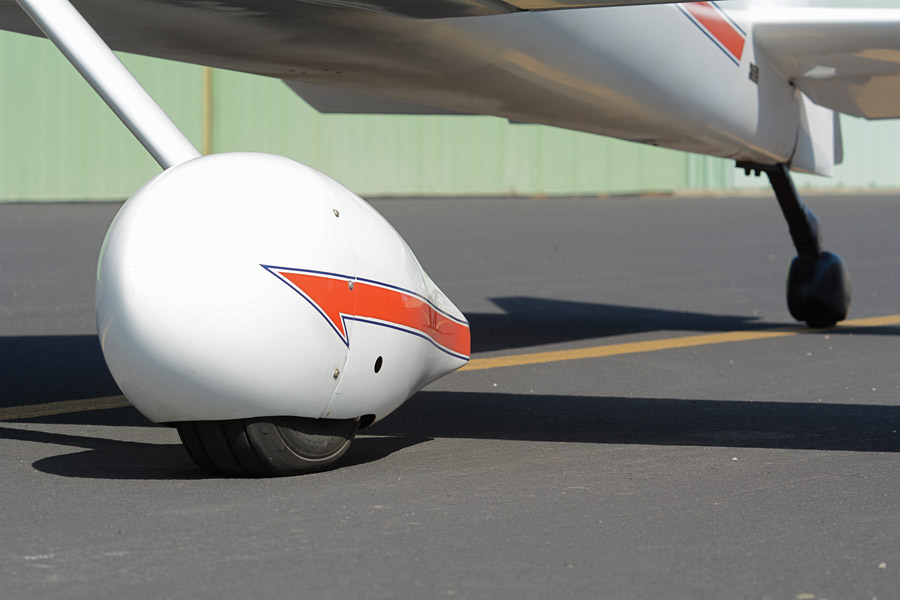
Saying “they’re great wheelpants,” Scott fitted RV-8 pants around his TR-1’s 5.00×5 main tires and Matco brakes. He also modified the standard, half-round TR-1 gear leg fairings to an airfoil shape but got nothing speed-wise for it. On the other hand, the RV-8 wheelpants, along with the tailwheel pant, slipped the TR-1 from 165 to 180 knots!
Scott figures the performance is mainly thanks to his TR-1’s lack of mass. It weighs a scant 805 pounds empty, and he specified the max gross at 1600 pounds, although “I don’t think I’ve ever flown over 1500 pounds. I put 1600 pounds on the paperwork just to make sure I’m always legal.” Payload is 795 pounds.
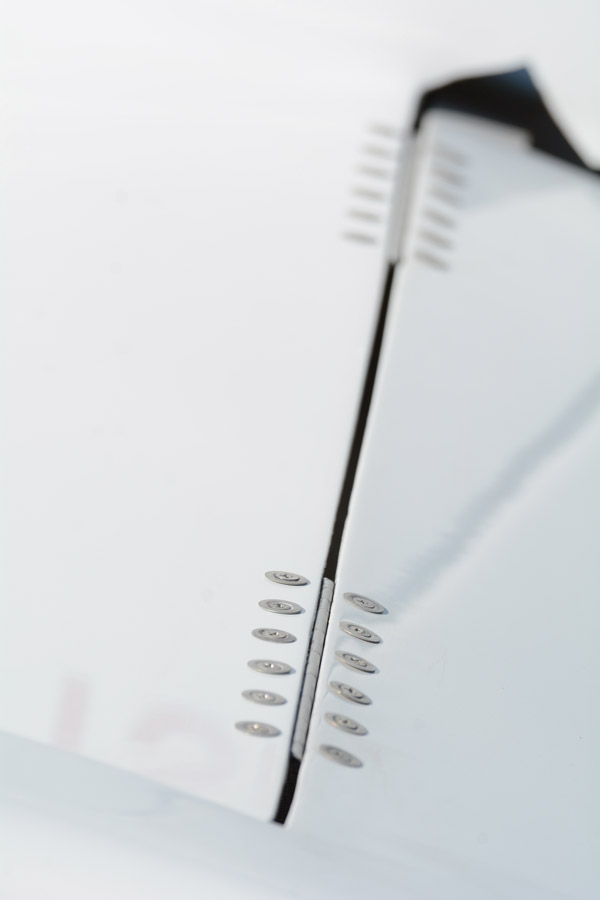
Richard Trickel’s vision for the TR-1 was to approach early Lancair performance with a simpler, easier-to-build kit, hence the Keep-It-Simple name. It’s also the reason the TR-1 uses plain piano hinges on all flaps and control surfaces, save the rudder.
Ultimately the KIS TR-1 marks a transitional point in homebuilt history. Birthed near the end of the plansbuilt to darn-near-finished kit migration, the design seems ideal for an owner such as Scott who enjoys having some of the heavy work already accomplished, but isn’t afraid to engineer his own systems and details.
And now if you see a TR-1, you’ll know what it is.
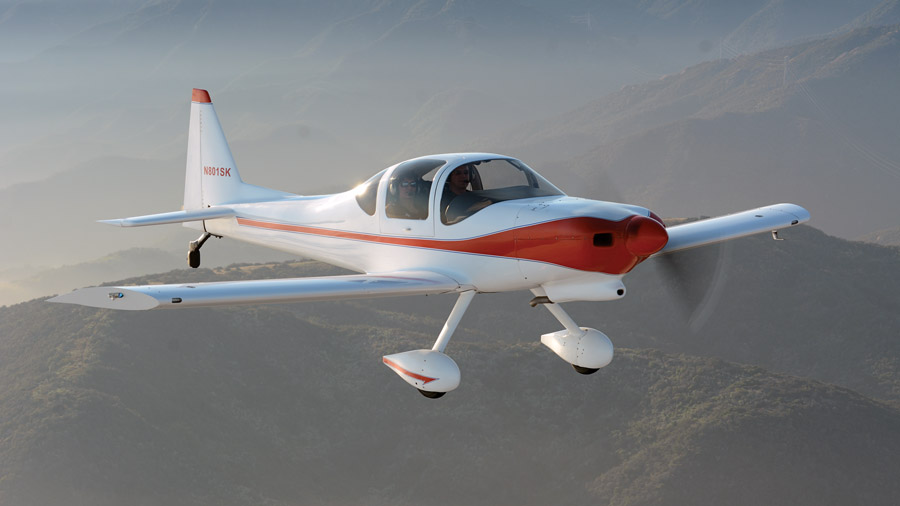
With its conventional yet somehow not quite familiar lines, the KIS TR-1 can stump many a plane watcher. The basic TR-1 kit finishes with either a tricycle or tailwheel layout; Stearns’ TR-1 TD is likely one of fewer than 10 such taildraggers in the U.S.


